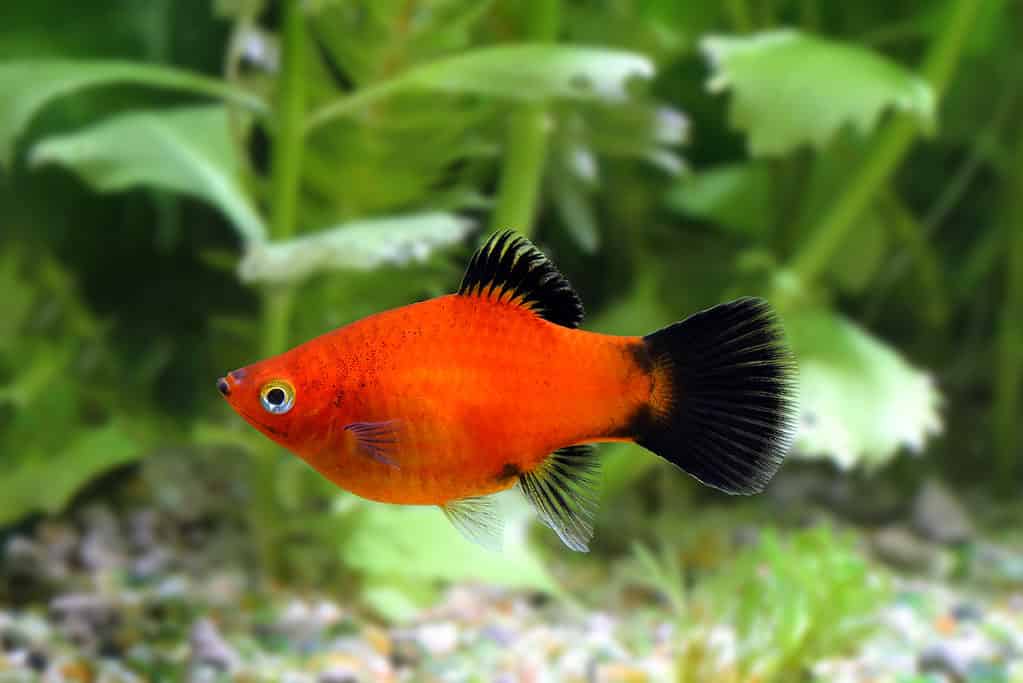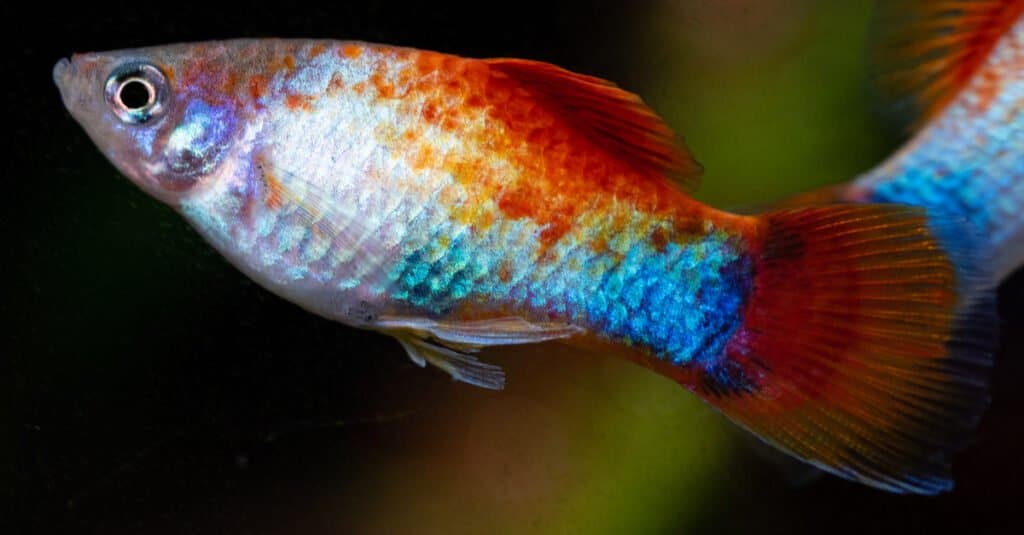Platies are beautiful aquarium fish that have been found in the pet trade industry since the 20th century. They make popular additions to tropical aquariums, where they can be kept in groups or with other live-bearing fish. Part of being a responsible fish owner is ensuring that your fish thrive in their environment under your care.
So, if you are looking into owning a platy fish, read this article. We discuss all the topics related to their lifespan. We also discuss how you can prolong platies’ lifespan and keep them healthy.
About Platy Fish
| Genus: | Xiphophorus |
| Origin: | Central America |
| Size: | 2 to 3 inches |
| Diet: | Omnivores |
Platy fish are small and brightly colored fish that originate from warm American waters. They can be found in the Amazon River basin and belong to the Poeciliidae family, which makes them live-bearing fish. Instead of laying eggs to reproduce, platies will give birth to live young known as fry (baby fish). You will find that platies rarely grow larger than 3 inches in captivity, and adults are usually around 2.5 inches in size.
It seems that platies get larger in their natural habitats rather than in home aquariums. They are freshwater fish that do best in spacious, planted, and heated tanks. Furthermore, platies are omnivores and thrive on a diet consisting of both plant and animal-based ingredients.

There are two main species of platy fish that are kept as aquarium pets.
©topimages/Shutterstock.com
There are approximately 26 species of platies and swordtail fishes under the Xiphophorus genus. So far, there are two common species of platy fish that are kept in captivity.
This includes the:
- Southern platy fish (Xiphophorus maculatus)
- Variable platy fish (Xiphophorus variatus)
However, these two species have been crossbred for a while now, so many of the platies you find in pet stores are a hybridized version of both these species.
The Average Platy Fish Lifespan

The average lifespan of a platy fish is around three to five years, regardless of the species. This is similar to many live-bearing fish like the guppy and molly fish. Platies generally aren’t considered to be long-lived fish, and there are several factors that can influence your platy fish’s lifespan that we will discuss below.
Genetics
A well-bred platy fish may have better genetics than one that has been poorly bred. Unfortunately, many platies are mass bred in less-than-ideal conditions to supply many pet stores. This means that breeders pay less attention to the qualities of the fish and try to breed for quantity instead. This may cause the platy fish to inherit certain undesirable traits and potential health problems. These health problems can affect how long your platy fish lives and shorten their lifespan.
Health
A healthy platy fish has a higher chance of reaching or even exceeding their lifespan in captivity. Many fish diseases can be fatal to small fish like platies which can cause them to die earlier than expected.
Lifestyle Factors
A platies tank’s conditions, diet, and water quality are going to influence their lifespan. When a platy fish is kept in improper conditions with poor water quality, they aren’t going to live as long as a platy kept in proper conditions. Also, your platy fish won’t be able to stay healthy and develop properly if they are fed the wrong diet.
A healthy and balanced diet is important in keeping your fish healthy and improving their lives according to aquatic veterinarian Dr. Jessie Sanders.
The 5 Life Stages of Platy Fish
Platies will go through five main life stages before living out their lifespan of up to five years.
Before Birth
Unlike many other types of fish, platies are livebearers that reproduce via internal fertilization. They do not hatch from eggs but rather develop in their mother before being birthed alive. You won’t be able to see a platy during this life stage until they are born. Pregnant platy fish will give birth after 24 to 36 days.
Fry (Birth to 1 Month)
Pregnant platies will give birth to around 20 to 80 fry at a time. These fry will be difficult to spot in aquariums and be nearly transparent at first because of their small size. They will spend the first few weeks of their lives hiding to avoid predators even in an aquarium. You will not be able to determine their colors and markings yet as they are too young.
Juvenile (1 to 4 Months)
Juvenile platies will begin to develop their adult colorations, although they will still be developing. They are not small enough to be considered fry and they are not sexually mature yet. Juvenile platies will be around 0.5 to 1.5 inches in size.
Young Adult (5 to 7 Months)
At around five months of age, platies will become sexually mature. This means that they are able to reproduce. Young adult platies will be around 2 inches in size and breeders will be able to determine what their final adult colors and marking will be.
Adult (8 Months to 5 Years)
At around eight months of age, platies will be considered adults. They would have developed their final adult colors and markings and reach a size of 2.5 to 3 inches.
How To Prolong Your Platies Lifespan

Platy fish can be found in a wide range of different colors and markings that are unique to the species.
©Celso Margraf/Shutterstock.com
The best way to prolong your platy fish’s lifespan is by ensuring that they are being properly cared for. Here’s how you can do that:
- Ensure that your platy fish are kept in appropriately sized freshwater aquariums. Avoid housing them in bowls, vases, and other smaller aquaria. Instead, house your platies in a standard fish tank larger than 20 gallons in size. The size of the tank should be upgraded depending on the number of platies you keep inside, and which life stage they are at.
- Equip your platies fish tank with a heater and suitable filtration system. As tropical fish, a heater is essential for platies and should be adjusted to maintain a water temperature of 70 to 80 degrees Fahrenheit. A good filtration system will help prevent the tank water from becoming stagnant while processing their waste.
- Feed your platies high-quality fish food. You should opt for omnivorous fish food like pellets that are formulated for live-bearing fish like platies. You can also supplement your platies diet with algae wafers or live foods like bloodworms and baby brine shrimp.
- As social fish, platies should be kept in groups of six or more. They can get stressed if they are kept alone or with incompatible tank mates. The group should ideally consist of more females than males to prevent breed-related stress.
- Lastly, any platies that are sick should be treated for disease. There are various aquatic medications available that target specific diseases and ailments in fish. It’s also recommended to move any sick platies to a separate tank to be treated to prevent the other platies from becoming sick or harmed by the medication.
The photo featured at the top of this post is © topimages/Shutterstock.com
Thank you for reading! Have some feedback for us? Contact the AZ Animals editorial team.







